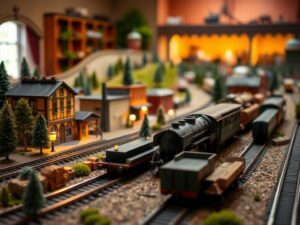Step-by-Step Guide to Wiring HO Scale Layout
Wiring an HO Scale Layout
Hey fellow railfans! Today, we’re diving into one of the most fundamental aspects of model railroading: wiring your HO scale layout.
I know the thought of all those wires can seem intimidating, but trust me, with a bit of patience and this step-by-step guide, youâll be laying down tracks and powering up your trains like a pro in no time!
Whether you’re just starting your railroading journey or looking to upgrade an existing setup, let’s get that power flowing and make those engines chuff!
1. The Foundation: Understanding Basic Electrical Principles
Before we jump into the nitty-gritty, let’s ensure we have a solid grasp of some basic electrical concepts:
- Current (Amps): Think of this as the flow of electricity, measured in amperes (amps).
- Voltage (Volts): This is the force pushing the current along, measured in volts. Our HO scale layouts typically run on 12-18 volts DC (Direct Current).
Our trains need a constant flow of electricity to move. The right combination of voltage and amperage ensures your trains have the power they need without risking overheating or damage.
- Resistance: Think of this as a barrier that opposes the flow of current, measured in ohms. Resistance is built into our components like motors and track.
By understanding these basics, we can effectively size up our electrical components to suit your layout needs!
2. Planning Your Power Setup: It’s All About the Strategy
- Determine Train Type: What kind of trains will you be running? Do you have high-draw power units like freight locomotives or lightweight passenger cars? Understanding this helps us choose appropriate power components.
- Layout Size and Complexity: A large, intricate layout needs a more robust power distribution system compared to a smaller setup.
Think about how many blocks (individual sections of track) you plan to have. Each block needs its own independent section for power and control, allowing us to manage train movement throughout the layout.
- Power Supply: The Engine Room:
Choose a reliable AC-to-DC power supply (also called a transformer or rectifier). Ensure it outputs enough voltage and current to handle your expected load â a common choice is an 18V variable power pack that can deliver up to 5 amps. Remember, oversizing the power supply is always better than undersizing it!- Variable Output: Look for one with variable output to control speed.
3. Wiring Essentials: Gathering Your Toolkit
You’ll need a few essential tools and materials to get the job done:
* Electrical Wire: 16-22 gauge insulated wire (hook up wire is commonly used). Make sure it’s rated for use with model train power systems. Consider stranded core wire, which provides better flexibility than solid core.
- Different colors: Using different colored wires for positive (+), negative (-), and common (Neutral) makes wiring much clearer! Red is often positive, Black negative, but you can always adapt that convention.
- Electrical Tape: Insulates connections to prevent shorts.
- Wire Strippers/Cutters: Make neat clean cuts and remove insulation cleanly.
-
- Solder and Soldering Iron (Optional): Soldering provides stronger, more reliable connections, especially in critical areas like switches and power distribution.Needle-nose pliers: Useful for working with tight spaces.
4. Setting Up the Power Block: Your Layout’s Electrical Heart
Let’s build the core of our wiring system â the power block!
- Switches: Each train section (block) needs its own dedicated control switch to turn power on/off. Use a panel with appropriately labeled toggle switches or even push-button momentary switches for advanced operation.
- Power Rails and Accessory Wiring: The Tracks That Talk:
HO scale model railroads rely on the principle of “collector rails” that pick up current. Run your main positive and negative wiring lines to two sets of parallel rails on your layout, typically the inner or outer pair, acting as “main busbars.” - Terminal Blocks (Optional but Highly Recommended):
These neat little boxes help keep connections organized and easy to manage. Use different sections of the block for your power feeds, track outputs, and any accessory wiring.
- Why are they so helpful?
- Clean Appearance:
Neatly grouped connections instead of wires tangling!
- Why are they so helpful?
- Expansion Friendly: Easily add more circuits or tracks without messy rewiring.
- Easy Troubleshooting: Identify and fix issues faster with clearly labeled wires.
Track Sections (Blocks): Connect each section of your track using short jumper wires to your power rails. This establishes independent circuits, allowing you to control train movement block by block.
- Important: Pay close attention to polarity! The red wire should always connect to the positive (+) rail on a given block and black to negative (-). Make sure each section is consistent throughout.
- *Switches: * These are often tricky. They need additional wiring connections to complete circuits when activated, sometimes involving “throw contacts” or reversing the flow of power in one track segment. Consult your switchâs instructions carefully.
- *Accessories: *Lights, signals, uncoupling systems â they all require separate power connections. Usually, you’ll connect these wires to accessory decoders that receive signals from your control system (e.g., DCC controller) and then manage power distribution to accessories based on commands.
- Return Path: Close the Loop:
Remember, electricity flows in a complete circuit! The negative wire should have a clear return path to the power supply. You often use a ground wire connected to each track section’s return rails or a central ground connection within your power block.
6. Safety First: Don’t Shock Yourself!
Always unplug your power pack before working on any wiring. Remember that electricity is powerful and potentially dangerous.
- Double-check all connections - no loose wires!
- Never Touch Bare Wires While Power Is On!: This could lead to a painful shock or damage to equipment.
7. Testing and Troubleshooting: Putting it All Together
Congratulations! You’ve successfully wired your HO scale layout!
Now, time for the satisfying part - testing! Start with simple checks:
* Test Individual Blocks: Use an Ohmmeter to confirm continuity between track sections and ensure that voltage is being delivered where it should.
- Observe Power Flow: If you’re using colored wires, carefully follow the current path. Make sure there are no breaks or short circuits disrupting the flow of electricity.
- Gradual Rollout: Test with one train at a time. Gradually add more locomotives and rolling stock as you gain confidence in your setup.
If you encounter any issues:
Double-check connections, looking for loose wires or shorts (unintentional electrical contact).
- Refer to the wiring diagrams provided with your components â switches, decoders, etc., often have specific instructions on how they should be wired.
Wiring an HO Scale Layout – Tips from a Seasoned Railfan
Let’s wrap up with some insights that come with years of building and troubleshooting model railroad layouts:
- Plan Ahead!: Sketching your layout plan with wiring routes marked helps avoid surprises and unnecessary rewiring later.
- Neatness Counts!: Label wires and terminals clearly to prevent confusion. This will make troubleshooting a breeze, especially when your layout grows more complex.
- Embrace Learning: Model railroading is an ongoing journey. Don’t hesitate to consult online forums, videos, or reach out to experienced hobbyists for advice.
Remember, every model railfan starts as a beginner. With patience, attention to detail, and this guide as your roadmap, you’ll have that HO scale layout buzzing with electrified fun in no time!









